Are you tired of grappling with clunky payment processes, frustrated customers, and missed growth opportunities? It’s time to revolutionize the way you handle transactions and take your business to new heights.
Contents:
Imagine a seamless, user-friendly payment service that empowers your customers to make instant transactions, simplifies your financial operations, and enhances your bottom line. Picture a world where sending and receiving money is as effortless as a single tap on a mobile screen. That world is within your reach.
In this comprehensive guide, we will show you how to create a payment service like Cash App, explicitly tailored to the needs of small businesses and startups. Whether you’re an e-commerce entrepreneur, a local retailer, or a service provider, this article is your roadmap to transforming your payment processes and unlocking the true potential of your business.
Benefits of creating your own payment service
The overall transaction value in the digital payments industry is expected to reach $9.46 trillion in 2023. Two-thirds of individuals globally give or receive money through digital processes. PayPal, Apple Pay, and Cash App are the most popular mobile payment services in the United States.
For startups and small businesses, integrating a payment service like Cash App into their operations can bring numerous benefits:
- Allows them to offer their customers a convenient way to make transactions, enhancing customer satisfaction and loyalty.
- Enables businesses to streamline their payment processes, reducing administrative tasks and costs associated with the manual handling of payments.
- Provides companies with access to valuable transaction data and insights, allowing for better financial planning and decision-making.
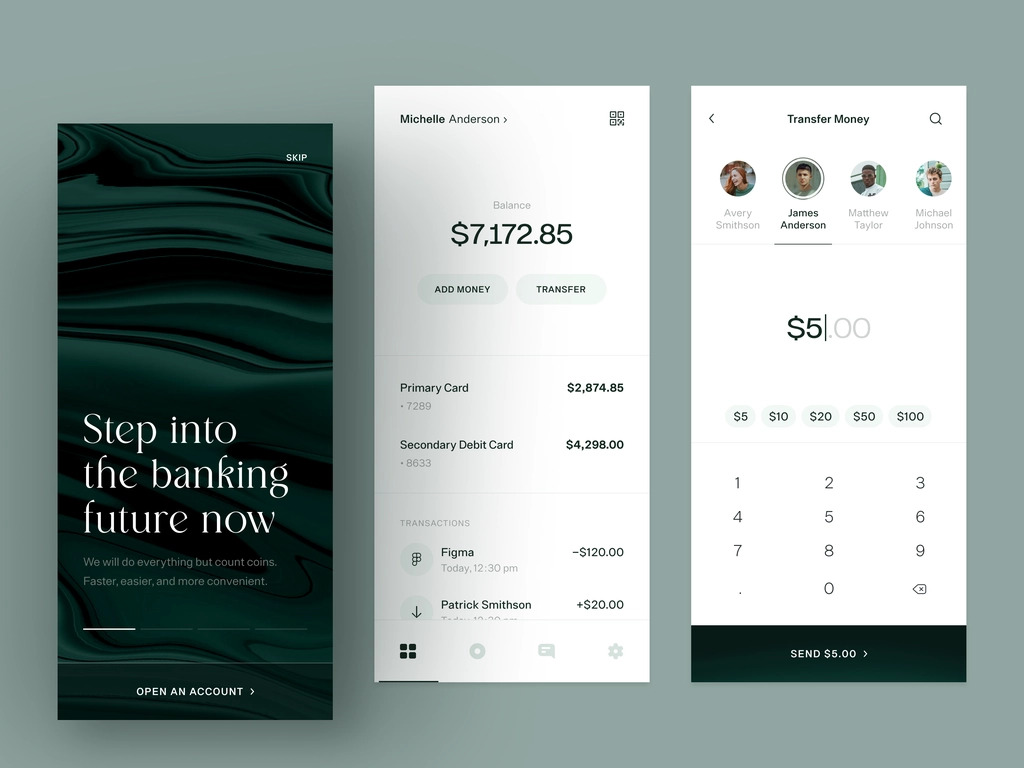
Finance Management Mobile App by Shakuro
What is Cash App?
Cash App is a mobile payment application that allows users to digitally transmit, receive, and keep money. It was released by a financial services and digital payments firm, Square, Inc. Individuals and organizations may use Cash App to conduct peer-to-peer payments, pay bills, and buy goods and services straight from their devices.
With this application, people may link their bank accounts or debit cards and transfer funds to other Cash App users with ease. Money transactions are quick, and, what’s more, the clients may request funds from others. The product also offers a “Cash Card,” which is a personalized Visa debit card that allows customers to make purchases with their Cash App balance at any physical or online business that accepts Visa.
There are also some extra features, such as Cash App Investing, which allows you to invest in stocks or Bitcoin, and a “Boosts” program. In return, you get discounts and prizes at certain retailers.
Here are some of the other key advantages:
- Easy and convenient: it has a user-friendly interface, making it simple to send and receive money. The application is easy to download and set up on mobile devices, allowing users to make transactions anytime, anywhere.
- Peer-to-peer payments: the product facilitates fast and seamless person-to-person payments. People can send money to friends, family, or anyone in their contact list with just a few taps on their mobile devices. It eliminates the need for cash or physical checks.
- Cash Card: it offers a free debit card that is linked to the client’s Cash App balance. This card can be used to make purchases at both online and physical stores that accept Visa. The card also supports contactless payments and offers ATM access to withdraw cash.
- Investing: there is a feature called Cash App Investing, which allows clients to invest in stocks and exchange-traded funds (ETFs) commission-free. It provides an easy way for individuals to start investing in the stock market directly from their accounts.
- Bitcoin support: users can buy, sell, and hold Bitcoin — a popular cryptocurrency. The mobile application offers a straightforward way for its customers to enter the world of digital currencies.
- Boosts program: this system provides users with personalized discounts and rewards at selected merchants. These boosts can be applied to purchases made with the Cash Card, allowing people to save money on everyday expenses.
- Cash App Cash-Out: people are able to transfer their balance to a linked bank account instantly. This feature provides flexibility and convenience when accessing funds.
- Security features: the money transfer app incorporates various security measures, such as fingerprint or PIN authentication, to protect user accounts and transactions. It also provides real-time notifications, allowing clients to monitor their activity closely.
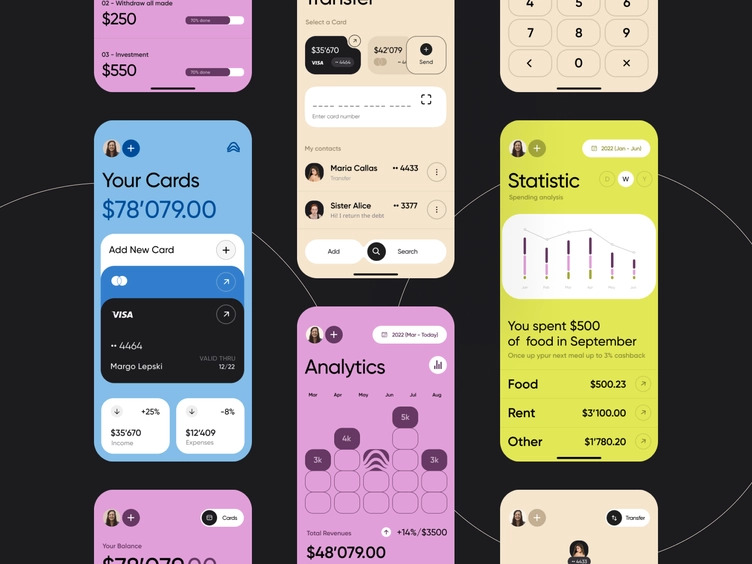
Fintech service – Mobile app by Anastasia Golovko
Essential and non-essential features for your application
Well, what should you pack under the hood of your project to make it as successful as the main competitors? Copying Cash App is not always a good idea, so consider these must-have options:
User registration and authentication: to take advantage of the app, people need an account. They should be able to provide the necessary information, and securely authenticate their identity to access the service.
Fund transfer: the ability to send and receive money securely and efficiently between users is the fundamental feature of any payment service.
Linking bank accounts or cards: there should be a possibility to connect bank accounts or debit or credit cards to facilitate transactions.
Payment tracking: to have control over their resources, users need a transaction history. So they can track their payment activities, including incoming and outgoing transactions.
Security measures: implement robust security features, such as encryption, two-factor authentication, and fraud detection to protect user data and prevent unauthorized access.
Instant notifications: provide real-time notifications for various activities, such as successful or failed transactions, and account balance updates.
P2P (person-to-person) payments: enabling users to easily send money to friends, family, or acquaintances using their contact information or unique identifiers gives your application more flexibility.
In-app balance and cash card: some instant payment services offer a digital balance within the application that can be used for transactions. Additionally, a linked debit card or prepaid card (like Cash Card in Cash App) can provide clients with physical payment options.
Cash out or withdrawal: it’s the ability for users to transfer funds from their digital balance to their linked bank account.
Customer support: provide various customer support channels for users to seek assistance, like in-app online chat, telephone number, email, etc, so they can report issues, or ask questions.
Already have the essential toolkit planned out? Then think about adding these optional features that enhance the user experience:
Peer-to-peer messaging: it allows people to communicate securely within the application to discuss payments, request funds, or send reminders.
Bill splitting: offer the functionality to split bills with friends or groups, making it easier to share expenses.
Digital wallet integration: consider integrating with other popular mobile wallet services like Apple Pay or Google Pay for convenient payment options. Be careful though, because payment integration of third-party services may not go easy on the development team.
QR code payments: this option will make the lives of your potential clients much easier, as they will just need to scan a code to make or receive payments. It will also simplify transactions between individuals and businesses.
Integration with merchants: allowing users to make payments directly to merchants for purchases or services, either in physical stores or online.
Cash boosts and rewards: provide users with cashback rewards, discounts, or special offers for using the payment service at specific merchants or for certain transactions. This will help you keep the user retention level and gain new customers.
Keep in mind that the importance of certain features may vary depending on the target audience, market, and competitive landscape. It’s essential to conduct thorough research and gather user feedback to determine which features would be most valuable to the intended users.
How to make a payment service like Cash App
Before getting started with actual development, you need to create a business plan and set up a system for your application. In terms of the plan, it’s better to begin with creating MVP(minimum viable product). It is the initial version of an app that is developed with a minimal set of features and functionalities required to satisfy early users and gather feedback. The goal of an MVP is to quickly validate the concept, test its viability in the market, and gather user feedback to inform future development iterations.
Setting up the system
As for the system, here are several points you have to consider:
Obtaining a license
Before launching a small business payment solution, it’s essential to obtain the necessary licenses and comply with the regulatory requirements of the countries you want to work in. Research the legal framework in your target market and apply for the appropriate licenses from the relevant authorities. Engage with legal experts to ensure compliance with financial regulations, data privacy laws, and anti-money laundering measures.
Choosing an infrastructure provider
To create a Cash App alternative, you’ll need a reliable infrastructure provider that offers secure and scalable solutions. Look for dealers that offer payment processing services, payment gateways, and fraud prevention tools. Evaluate their track record, security measures, and technical support to ensure they meet your business requirements.
Setting up accounts
Create accounts with financial institutions, such as banks or payment processors, to facilitate fund transfers and handle transactions. Establish partnerships with reputable financial institutions that align with your target market’s preferences. Ensure a seamless connection between your payment service and these accounts to enable smooth money transfers and payment settlements. Don’t forget about planning a customer account management system, so that your support team and administration can control the processes.
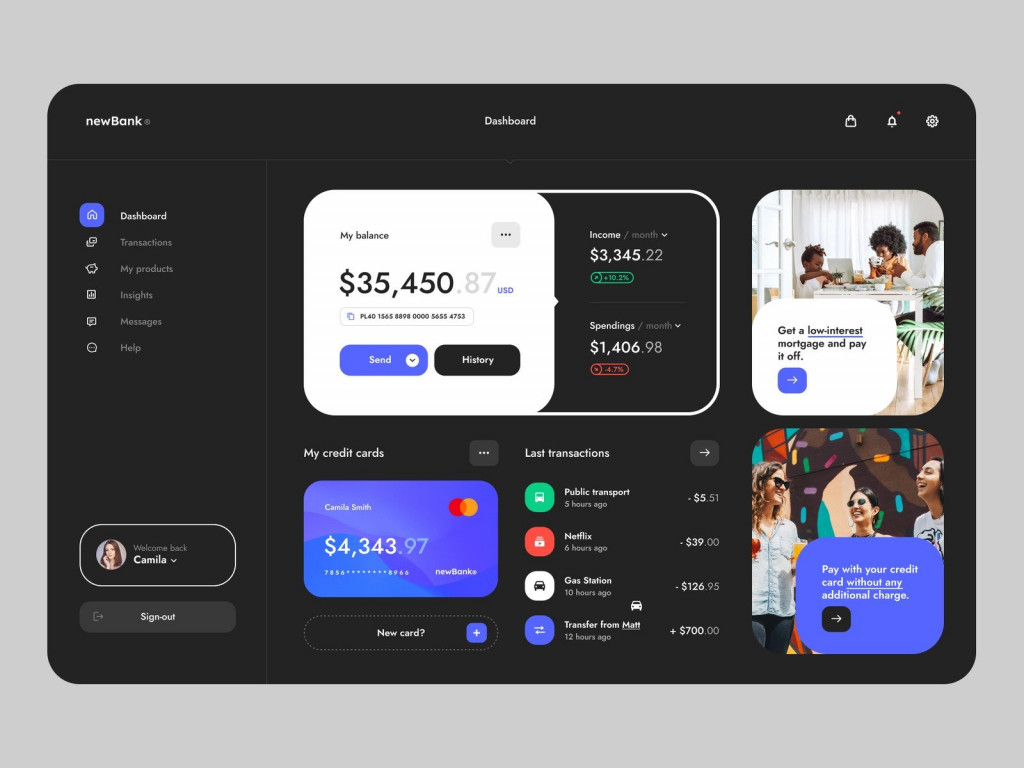
Web-app concept shots by Matt Wojtaś
Predicting the costs
As you’ve probably guessed, the possible expenses depend on tons of factors. If you pair up with an outsourcing development team, then the average hourly rate is $40-45 for development and $70-80 for design. Which is about 50% cheaper than the rates for an in-house team.
If you start the process from scratch with static 2D images, logos, and essential features like authorization, member profiles, dashboards, and others, then be ready to pay approximately $24 700 for development and $44 000 for UI/UX design. In terms of time, that will be around 550+ hours. In case you want a custom approach, then prices will spike and hit almost 1 150 hours (~$143 750 for both parts in total).
You must also calculate costs for QA engineering, usability tests, promotions, hosting, ASO, future updates, etc. To learn the approximate cost of developing a mobile application, you can use a special tool like Project Calculator. With its service, you will find out the costs for branding, design, and development.
Developing your mobile platform
Once the preparations are done, it’s time to switch to mobile development.
Coming up with a design
Start with creating concepts and stylescapes based on the information from the target audience. This will help you decide on the color scheme, style, and user flow. Conduct market research to understand user preferences, pain points, and industry trends. Create wireframes and prototypes to visualize the user experience and gather feedback from people. As a result, you’ll design a user-friendly and intuitive mobile platform that caters to the needs of your potential clients.
Building the mobile application
Collaborate with experienced mobile app developers to build the payment service app. There are several ways, for example, you can find an outsourcing team or hire an in-house team for more control. In any case, the specialists will recommend the frameworks and tech stacks that suit your project, as well as integrate payment API. You can also consider using cross-platform frameworks like React Native or Flutter to develop a single codebase that can run on both iOS and Android devices.
Remember about MVP and focus on integrating features such as peer-to-peer payments, in-app payments, and a virtual debit card. Ensure the app’s performance and compatibility across different devices and operating systems.
Testing the product
Thoroughly test the payment service application to identify and fix any bugs, glitches, or vulnerabilities. Perform different kinds of testing like functional, usability, and security tests to ensure a seamless user experience on various devices and protect against potential threats. Then you can engage with beta testers and gather their feedback to enhance the performance and usability further.
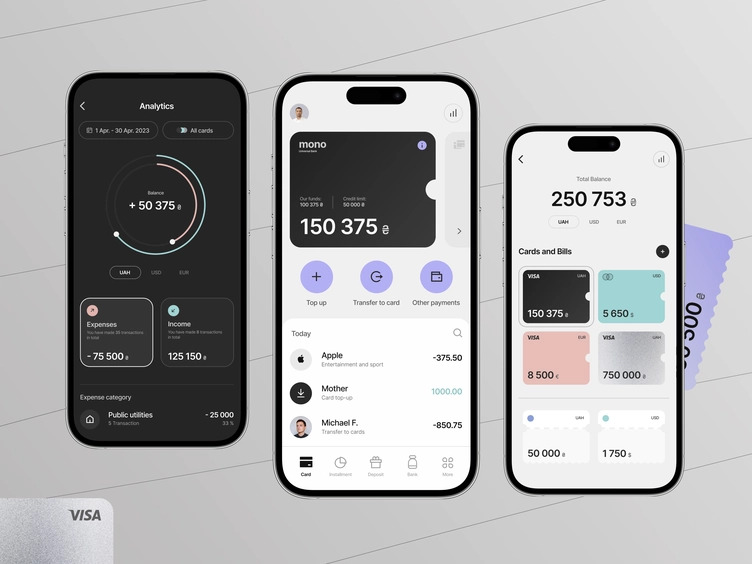
Mono by Ruslan Ch.
Securing transactions
Impenetrable security is a must-have for payment services, so it should also be your primary concern. If the clients’ data is vulnerable to cyberattacks, your reputation will be at stake.
Overview of payment security measures
Payment fraud prevention is crucial to building trust and protecting user data. Implement industry-standard security measures such as encryption, tokenization, two-factor authentication (2FA), single sign-on (SSO), and secure socket layer (SSL) protocols. Regularly monitor and update your security systems to stay ahead of emerging threats and vulnerabilities.
Setting up security protocols
Collaborate with cybersecurity experts and perform security assessments to establish robust protocols for your startup payment service. Implement strict access controls and reliable network architecture. To create a strong bond with users and ensure protection from the other side, educate your clients on best practices for online security and fraud prevention. They can be done in the form of pop-ups, hints, newsletters, or even articles in your company’s blog.
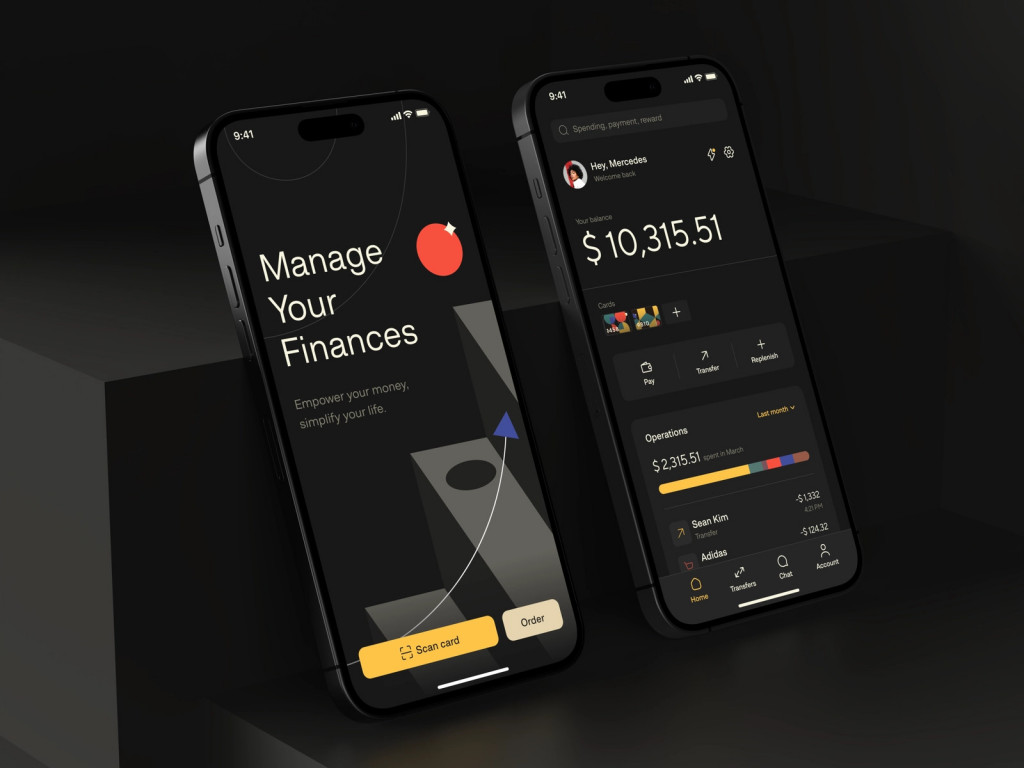
Finance Management Mobile App by Conceptzilla
From idea to reality: concluding strategies to launch your own Cash App
Payment services offer startups and small businesses numerous advantages, including improved customer experience, streamlined payment processes, and access to valuable statistics. However, it’s essential to consider potential challenges such as regulatory compliance, security risks, and the need for ongoing maintenance and support.
Creating a payment service like Cash App requires careful planning, collaboration with industry experts, and attention to detail. By following the steps outlined above, you can develop a secure online payment platform that meets your customers’ needs. Remember to stay updated on the latest trends, technology advancements, and user feedback to improve and evolve your product continuously.
Don’t let outdated payment processes hold your business back any longer. It’s time to join the digital revolution and offer your customers a seamless user experience that sets you apart from the competition. Contact us and let’s develop a versatile application with robust security and great user flow.
